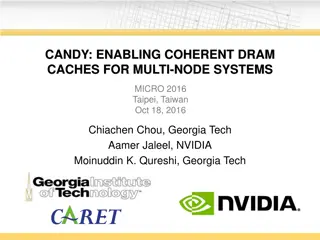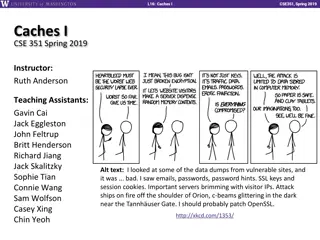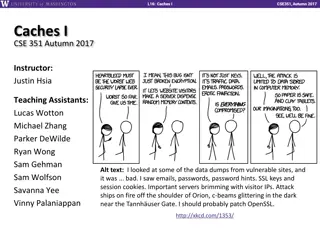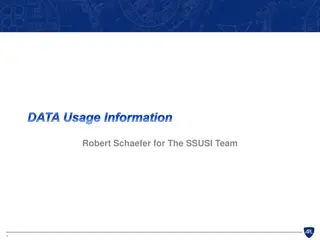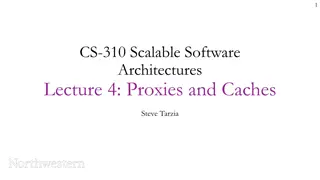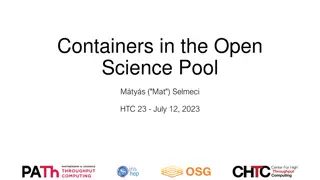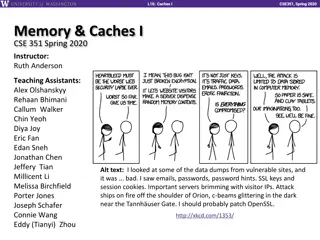Summer Fellows 2024: Dive into OSDF Caches and IP Geolocation Challenges
Explore the Summer Fellows 2024 program focusing on topics like Glideins, IP geolocation challenges, OSDF Caches, and the use of AI in OSPool Failure Classification. Participants delve into learning the GlideinWMS system and grappling with issues related to network latency, hops, and machine learning for job classification. Discover the innovative approaches to addressing complex technological challenges in a collaborative environment.
Download Presentation

Please find below an Image/Link to download the presentation.
The content on the website is provided AS IS for your information and personal use only. It may not be sold, licensed, or shared on other websites without obtaining consent from the author.If you encounter any issues during the download, it is possible that the publisher has removed the file from their server.
You are allowed to download the files provided on this website for personal or commercial use, subject to the condition that they are used lawfully. All files are the property of their respective owners.
The content on the website is provided AS IS for your information and personal use only. It may not be sold, licensed, or shared on other websites without obtaining consent from the author.
E N D
Presentation Transcript
Where In The World Am I? Neha Talluri Mentor: Jason Patton
What is a Glidein? A glidein runs on shared resources to create more execution points Glideins assess the worker node they are on by gathering information and utilizing pre-configured data Location of a Glidein is currently not discovered or provided Institutions may not be co-located with the resource 3
IP Geolocation Problematic Kansas problem 4
Where Am I? Location: is the distance to some known entity Distance: Network latency and hops Answer Where are glideins in relation to known entities? Entities = OSDF Caches 5
What Ive Been Doing Learning the glideinWMS system through running OSPool jobs and kicking off glideins Developing glidein scripts to gather network information and advertise this information to the machine ad and glidein logs Figuring out how to answer Where am I? Testing IP geolocation using different IP addresses Figuring out how to use tracepath to figure out latency and hops 6
Machine Learning for OSPool Failure Classification Thinh Nguyen Mentor: Justin Hiemstra 8
An Example Lifecycle of a job During a job s execution it can go on hold for various reasons User s discretion to release or remove it 9
Using AI to Make the Inference Why AI? OSPool is a Dynamic system Continual learning 10
Usage 11
How? Each job has a log file describing its lifecycle Format these logs into a time-series structure Use model that accounts for temporal patterns e.g. Long Short-Term Memory (LSTM) neural network 12
Bonus Can the model provide information as to why the job went on hold? 13
Thank you, Questions? https://github.com/super10099/Machine-Learning-for-OSPool-Failure- Classification 14
Expanding Pelican Origin Monitoring Patrick Brophy 15
Who Am I? My name is Patrick Brophy I am a senior at UW Madison studying computer science CHTC Fellow working with Haoming Meng London Lucky 16
Problem: Diagnosing an Origins Health Pelican Origins are the backbone to a data federation Connects and Serves an object store Origins are critical within a federation, no origins -> no data If an origin goes down so does the data that it was serving A staging device can t stage data if it can t access an origin Diagnosing why an origin is failing is difficult with the current tooling 17
Improving the Dashboard I conducted a user study with several Pelican system admins from CHTC and OSDF Feedback from system admins guided design choices 20
Whats Next? More Metrics! XRootD protocol-level (HTTP) metrics Alerting users of issues such as outages or warnings Reporting performance metrics for some period of time (day, week, month) Staging Device miss rate # of Objects accessed Total bytes transferred 25
Thank you! Please come and ask me questions! 26
Integrating Pelican with Pytorch CHTC Summer Fellow: Kristina Zhao Mentor: Ian Ross, Emma Turetsky
Integrating Pelican with Pytorch Introduction Dataset stores the samples and their corresponding labels Pelican DataLoader wraps an iterable around the Dataset to enable easy access to the samples. PyTorch HTCondor
Integrating Pelican with Pytorch Problem Data Accessibility Large Size Remote Performance: low metadata latency high data throughput
Integrating Pelican with Pytorch Goals Streamlined Workflows CLI Pelicanfs (implement fsspec) Smoother integration Less time on tools Efficient Data Handling Make our AI Researchers happier
Integrating Pelican with Pytorch Methodology Research - Pelican, fsspec, Pytorch data flows and requirements - Real world scenario: File format, file size, resource, limitation, Benchmark Develop tools/libraries Tutorial and Documentation
Integrating Pelican with Pytorch Methodology Research on Pelican and PyTorch data needs Benchmark - local - Pelicanfs - Pelicanfs + Local Cache - Pelicanfs + zip file Develop tools/libraries Tutorial and Documentation
Integrating Pelican with Pytorch Methodology Research on Pelican and PyTorch data needs Benchmark Develop tools/libraries - Pelicanfs - Pelican connector? Tutorial and Documentation
Integrating Pelican with Pytorch Methodology Research on Pelican and PyTorch data needs Benchmark Develop tools/libraries - Pelicanfs - Pelican connector? Tutorial and Documentation
Integrating Pelican with Pytorch Methodology Research on Pelican and PyTorch data needs Benchmark Develop tools/libraries Tutorial and Documentation
Integrating Pelican with Pytorch Thank you! Discussion and Problems welcome! Kristina Zhao hzhao292@wisc.edu
Enhancing the Building of the OSG Container Images Pratham Patel 37
Who Am I? Hometown: Beloit, WI Senior at UW-Madison studying CS & DS I m pretty awesome Just deal with it! 44
Enhancing the OSG Container Build System A Three-Phase Approach to Versatility and Efficiency Abstract: CHTC builds images for sites to run and for use internally. Images are based on upstream OS container images We build all images at least once a week Focus: Adding versatility and streamlining the build process within the OSG images repository. Three-phase approach: 1. Customizable build instructions for each image. 2. Dynamic trigger for external repositories. 3. Compatibility and support for ARM-based systems. 39
Image X 1 2 1 3 4 5 OSG 3.6 + EL7 10 6 7 8 9 OSG 23 + EL9 Build Parameters 15 12 14 13 11 Development 16 20 18 19 17 21 Testing 22 23 24 25 26 27 Release Multiply that by 27 images built multiple times a week and we run into issues 6 individual build for image X 40
Background Current State: GitHub Actions Workflow: Automates building and pushing container images. Triggered by specific conditions and events. Monolithic Design: Lack of flexibility in the build process. All images built using a single, unified workflow. Additional Features: Not supported for ARM architecture. 47
Project Requirements Versatility: Mechanism for custom build processes through a unique configuration file. Default instructions in absence of unique configuration file. Trigger Mechanism: Located in the images repository. Activates updates with Pelican and other external repositories. ARM Compatibility: Add support for building native ARM-based systems. Aim for ARM-optimized Pelican images. 42
Solution Phase 1: Customizable Build Instructions Objective: Establish an advanced image repository framework with configurable build instructions. Implementation Paths: Dynamic parameters for building images. Modularize workflow into reusable components. Phase 2: Triggering the Pelican Repository Objective: Integrate with the external repositories using a trigger. Implementation Paths: Create some trigger in the images repository. Use GitHub Actions to monitor and trigger Pelican repository and others. Develop GitHub Action in Pelican repository to handle the trigger for updates. 49
Conclusion Summary: Implementing a three-phase approach that enhances flexibility, efficiency, and future- readiness. Custom build instructions, trigger for external repositories like Pelican, and ARM-based support. Next Steps: Refine customizable build instructions Work with Pelican team to determine trigger strategies 44
CHTC Fellowship: Tracking Server Inventory and Elevation Ben Staehle
Who am I? My name is Ben Staehle Madison native - currently at UW-Madison This summer - CHTC Fellowship - Working with Joe Bartkowiak on Tracking Server Inventory and Elevation - - - Willow Me
What are we solving? CHTC maintains more than 1200 assets System administrators are responsible for maintaining inventory records Interested stakeholders include UW-Madison, Morgridge Institute for Research Previous internal asset tracking was cumbersome - - - - 2
Thank you! Questions?






